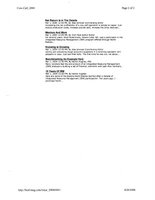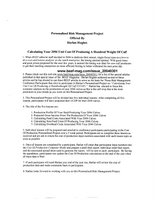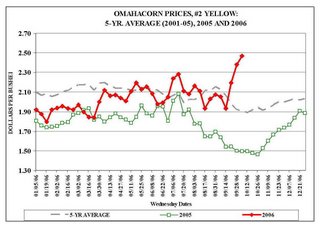To access these articles, go to www.Beef-Mag.com, scroll down towards the bottom and click on "See more from Harlan Hughes" and this list will come up on your screen. Double click the article name to load that article into your computer. Use your browers's print command to print the article.
Good accounting Part III
Feb 1, 2007, by Harlan Hughes contributing editor
I suggested ranchers look to their on-ranch accounting systems to answer two key business-management questions...
Good accounting Part II
Jan 1, 2007, by Harlan Hughes, contributing editor
Last month, I summarized how some ranchers are being let down by their on-ranch accounting systems. This month, I'll focus on good accounting and how...
Bad accounting Part 1
Dec 1, 2006, by Harlan Hughes contributing editor
Today's ranch businesses are dramatically different from those of years ago. Previously, profit margins were such that the more beef you produced, the...
The perfect beef-cow-lease
Nov 1, 2006, by Harlan Hughes contributing editor
The 2002 and 2006 droughts have stoked interest in beef-cow leases, as drought-impacted ranchers seek to lease their cows to operators with grass and...
Planning prices revised upward
Oct 1, 2006, by Harlan Hughes contributing editor
Prices continue strong for cow-calf producers. As of late August, the 2006 drought has had little impact on cattle prices, and drought-induced early weaning...
What's a fair cow share lease?
Sep 1, 2006, by Harlan Hughes contributing editor
As the nation's drought expands and worsens, I get more calls on the economics of moving a cow herd to another ranch for feeding over the next year. Typically,...
Calculating gross income accurately
Aug 1, 2006, by Harlan Hughes contributing editor
Most ranchers don't accurately calculate the gross income of their beef cow herds. A correct economic analysis should be based on the accrual-adjusted...
UCOP will tell your story
Jul 1, 2006, by Harlan Hughes contributing editor
A statistical analysis of my Northern Plains 1990s beef cow Cost & Return Database suggests weaning weight explained only 20% of herd-to-herd variation...
Planning prices for future markets
Jun 1, 2006, by Harlan Hughes contributing editor
This article is the last in my series on how to make the cattle cycle work for you. Readers should now understand the 10- to 12-year cattle cycle and...
Weathering the cycle's end
May 1, 2006, by Harlan Hughes contributing editor
We know a typical cattle cycle lasts 10-12 years. We also know cattle inventory cycles are the fundamental factor behind beef-price cycles. Such random...
Today's strong bred cattle market
Apr 1, 2006, by Harlan Hughes contributing editor
The U.S. bred female market is very strong. In mid February, some 2-year-old Montana heifers sold for $1,650/head. Given that today's calf prices aren't...
4 winning market strategies Part V
Mar 1, 2006, by Harlan Hughes contributing editor
The key point in this five-article series has been that once a rancher believes in cattle cycles, he can make the cycle work for him. The net result is...
Working the Cycle-- Part IV
Feb 1, 2006, by Harlan Hughes contributing editor
This month, I'll share a management strategy ranchers can use in making the cattle cycle work for them. This is a strategy high-profit ranchers taught...
Working the cycle Part III
Jan 1, 2006, by Harlan Hughes contributing editor
In the November issue, we discussed the cattle cycle and its 10- to 12-year cyclical nature. I suggested that if a rancher fights the cattle cycle, it...
Cattle/beef price-cycle relationship Part II
Dec 1, 2005, by Harlan Hughes contributing editor
All experienced cattlemen know cattle prices go boom to bust and back again that's the cattle cycle. In fact, cattle and slaughter numbers, and cattle...
Working the cattle cycle Part I
Nov 1, 2005, by Harlan Hughes contributing editor
My lectures of the last decade have focused a lot on the cattle cycle and its resulting beef price cycle. My key message has been that if you fight the...
The economics of culling cows
Oct 1, 2005, by Harlan Hughes contributing editor
While most producers direct energy toward marketing steer calves, few do the same for marketing cull cows. Ten years of economic analyses for Northern...
Six steps to an optimal marketing plan
Sep 1, 2005, by Harlan Hughes contributing editor
By now, most of you are pondering marketing your 2005 calves. Thus, I'll share my most recent planning price projections and the management implications...
Cost control is in the details Part III
Aug 1, 2005, by Harlan Hughes contributing editor
Benchmarking is comparing your beef cow herd's production, financial and costs of production measures to those from a set of benchmark herds. Last month,...
What benchmarking can tell you
Jul 1, 2005, by Harlan Hughes contributing editor
Let's look at what benchmarking the act of comparing a beef cow herd's production and financial measures to those of a set of benchmark herds can tell...
Profiting on 2005 calves Part I
Jun 1, 2005, by Harlan Hughes contributing editor
Now is the time to think about generating the maximum possible profit from your 2005 calves. It begins by fully analyzing the production of your 2004...
The worst and best herds
May 1, 2005, by Harlan Hughes contributing editor
Managing a profit into beef cows without detailed management data is becoming increasingly difficult. Inflating production costs tend to negate much of...
Increasing your profits Part III
Apr 1, 2005, by Harlan Hughes contributing editor
With calving season upon us, I hope you're recording your calves' birth dates and their dam numbers in a calving book. If so, all you need to generate...
Increasing your profits Part II
Mar 1, 2005, by Harlan Hughes contributing editor
Record-high calf prices in 2004 should have generated record-high profits. Yet, only one out of my last six herds analyzed generated record profits. The...
Something's amiss with profit part 1
Feb 1, 2005, by Harlan Hughes contributing editor
As I continue to conduct cost and return analyses for U.S. beef cow producers, I see today's record calf prices aren't translating into record profits...
Dec 1, 2004, by Harlan Hughes contributing editor
Last month, I suggested that a fall 2004 preg-checked bred heifer that will produce seven consecutive calves has a calculated economic value of $1,560....
What's a bred heifer worth this fall?
Nov 1, 2004, by Harlan Hughes contributing editor
As more normal rainfall patterns return, ranchers will need to repopulate their herds. The good news: bringing bred heifers into your herd over the next...
Zap up your info system
Oct 1, 2004, by Harlan Hughes contributing editor
Beef cow producers are in the midst of exciting economic times. It's an excitement, however, that the industry experiences at this point in every cattle...
40 years of on-farm computing
Sep 1, 2004, by Harlan Hughes contributing editor
By focusing on the last 40 years of on-farm computing for farmers and ranchers, my goal is to stimulate ranchers to move from a traditional production...
Sell 2004 steers off grass
Aug 1, 2004, Harlan Hughes
As this piece was written in late June and early July, USDA had just announced two false-positive bovine spongiform encephalopathy (BSE) fast-test cases....
The money is in the details
Jul 1, 2004, Harlan Hughes
During the 1990s, I helped implement Integrated Resource Management (IRM) in the Northern Plains. Part of this consisted of going from kitchen table to...
Post-BSE market price tracking Part 1: Slaughter cattle prices
Apr 1, 2004, Harlan Hughes
Last month's Market Advisor column focused on the immediate market price impact of North America's second case of bovine spongiform encephalpathy (BSE)...
Post-BSE damage control strategies
Feb 1, 2004, Harlan Hughes
Damage control has to be uppermost in the minds of most ranchers in light of USDA's Dec. 23 announcement of a single case of bovine spongiform encephalopathy...
The story from up North
Jan 1, 2004, Harlan Hughes
May 20 and Aug. 8 of 2003 are well implanted in the minds of Canadian cattlemen. May 20 was the date the discovery of a single case of bovine spongiform...
How high and how long?
Nov 1, 2003, Harlan Hughes
As beef cow producers approach the weaning of their 2003 calves, market prices are at or near record levels. Two key questions are why are calf prices...
Good times are a'coming
Oct 1, 2003, Harlan Hughes
All indications are that several years of good economic times have returned to the cow-calf sector. Feeder cattle prices, driven by record-high slaughter...
Post-drought management Part III
Sep 1, 2003, Harlan Hughes
Managing a farm or ranch is never easy, but it's especially difficult during drought and its aftermath. Integrated business planning (IBP) can help you...
Managing the EZ-Way Part II
Aug 1, 2003, Harlan Hughes
A proper ranch management analysis must be based upon on-farm data specific to that ranch. It's from such data that long-term drought solutions and planning...
Managing post-drought, the EZ-Way
Jul 1, 2003, Harlan Hughes
Spring rains in cow country are turning many ranchers' attention toward drought recovery. For some drought-affected ranchers, that means repopulating...
For intensive managers, COOL will be a snap
Jun 1, 2003, Harlan Hughes
The country-of-origin labeling (COOL) law that takes effect Sept. 30, 2004 requires ranchers to verify the cattle they sell as born and raised in the...
Strong U.S. dollar works against U.S. producers
May 1, 2003, Harlan Hughes
This winter, I toured Brazil to visit with beef and soybean producers, and then spent several weeks in Canada visiting with Canadian beef producers. Upon...
Brazil, 33 years later
Apr 1, 2003, Harlan Hughes
In early February, my wife and I accompanied a farm and ranch tour of Brazil sponsored by BEEF and The Corn And Soybean Digest (formerly Soybean Digest)...
Look forward for price signals
Mar 1, 2003, Harlan Hughes
Today's roller-coaster cattle prices are largely attributable to extended drought in the western U.S. and western Canada, and the cattle cycle's delayed...
So Happy Together
Feb 28, 2003, By Harlan Hughes
Given rising carcass weights, increased production costs and unpredictable market prices, astute beef-cow producers are always searching for more efficient,...
Pasted from Labels: LIst Of My Market Advisors On BEEF Magazine Web Site
posted by Dr. Harlan Hughes 3:17 PM [edit]
























